Wandering through the Southeast Asian galleries at New York’s Metropolitan Museum of Art over Christmas, I was struck by the glory of the bronzes produced in Java more than 1,000 years ago. And of their prescience. This depiction of the Shakyamuni Buddha suggests that in 10th Century Java, the Gods were already playing with their Blackberrys.
Tag Archives: Telecommunications
Indonesia’s True Religion
The essentials of life: handphones where there’s no power

Just a couple of years ago, it was a source of wonder: “Wah! In Indonesia, even the hookers/farmers/becak drivers have cell-phones!” The citified loved to take photos of small buffalo-riding Javanese children or half-naked Papuan adults busily chatting on their cell-phones (HP, or “hah pay” in Indonesian, from the English Hand Phone). Now, cell-phones are such a universality that no-one even bothers to take note. But I still find it amusing that cell phones have entrenched themselves quite so firmly even in places where there’s no electricity. This has led to a whole secondary industry, illustrated by the roadside stall in the small town of Enarotali, in the highlands of Papua, pictured above.
CASS HP: what can it mean? In Indonesian, “C” is pronounced “Ch”: Chass HP, the local rendering of Charge HP. This shop will fill your battery for you, for 5,000 rupiah, about 50 cents. You’ll find stalls like this all over Indonesia, and plenty of people using them even in areas with no phone signal, especially near areas where electricity is sporadic or non-existant. Because after all, even if you can’t talk to anyone on it, a charged phone makes a very good torch.
Notional Networks: the realities of Indonesian Telecoms

In my proposal for Taking Tea with the Dead, I wittered on at some length about how fabulously plugged in Indonesia is. The world’s second largest Facebook community, some 18 percent of all Twitter traffic. Jakarta pulsates a glorious crimson on this wonderful Twitter heat map at most times of the day and night.
But as Merlyna Lim reminded us in a recent report on democratization and social media in Indonesia (pdf), most of those people live in Java and Bali, with a smattering in large cities in other islands. Since I’ve started my travels far from the mother-lode, I can identify especially with this map, taken from Lim’s report, of telecoms distribution.

And let’s not forget that that phone pictured above, under lock and key in a Waikabubak guest house, counts as part of the 0.2 percent. I’m hoping some of those open source guys can find a way for us to Tweet by tom-tom.

